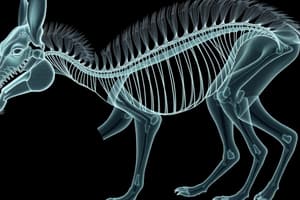Podcast
Questions and Answers
Which of the following is NOT a major animal group?
Which of the following is NOT a major animal group?
- Amphibians
- Tetrahedral (correct)
- Arthropods
- Mollusks
What is the basic unit of classification in the taxonomic hierarchy?
What is the basic unit of classification in the taxonomic hierarchy?
- Species (correct)
- Family
- Genus
- Order
What does the term 'Cladistics' refer to in modern classification approaches?
What does the term 'Cladistics' refer to in modern classification approaches?
- Classification based on evolutionary relationships
- Classification based on common ancestry (correct)
- Classification based on ecological roles
- Classification based on morphological traits
Which of the following classification criteria focuses on physical structure and form?
Which of the following classification criteria focuses on physical structure and form?
Which taxonomic category is broader than 'Kingdom'?
Which taxonomic category is broader than 'Kingdom'?
Flashcards are hidden until you start studying
Study Notes
Animal Classification
1. Introduction
- Animal classification, or taxonomy, is the scientific method of categorizing animals based on shared characteristics.
- Key goals: identification, naming, and organizing animal diversity.
2. Taxonomic Hierarchy
- Domain: Broadest category (e.g., Eukarya)
- Kingdom: Major groups (e.g., Animalia)
- Phylum: Grouping based on body structure (e.g., Chordata)
- Class: Grouping within phylum (e.g., Mammalia)
- Order: Further subdivision (e.g., Carnivora)
- Family: Closer related groups (e.g., Felidae)
- Genus: Closely related species (e.g., Panthera)
- Species: Basic unit of classification (e.g., Panthera leo)
3. Major Animal Groups
- Invertebrates (no backbone)
- Examples: Arthropods, Mollusks, Annelids
- Vertebrates (backbone)
- Example classes:
- Fish (Osteichthyes, Chondrichthyes)
- Amphibians (e.g., frogs)
- Reptiles (e.g., snakes)
- Birds (e.g., sparrows)
- Mammals (e.g., humans)
- Example classes:
4. Key Classification Criteria
- Morphological: physical structure and form
- Genetic: DNA and genetic relationships
- Behavioral: mating, feeding, and social behaviors
- Ecological: habitat, niche, and role in the ecosystem
5. Modern Classification Approaches
- Phylogenetics: uses evolutionary relationships to classify organisms.
- Cladistics: categorizes based on common ancestry and branching diagrams (cladograms).
- Biodiversity and Conservation: classification aids in conservation strategies by identifying species at risk.
6. Importance of Animal Classification
- Facilitates communication among scientists.
- Aids in understanding evolutionary relationships.
- Essential for conservation efforts and biodiversity studies.
Animal Taxonomy: The Science of Classification
- Taxonomy organizes animals based on shared traits for identification and understanding biodiversity.
Taxonomic Hierarchy: A Nested System
- Eight hierarchical levels classify organisms from broadest to most specific: Domain, Kingdom, Phylum, Class, Order, Family, Genus, Species.
- Each level groups organisms with increasingly similar characteristics.
- Example: Humans are in the Eukarya (Domain), Animalia (Kingdom), Chordata (Phylum), Mammalia (Class), Primates (Order), Hominidae (Family), Homo (Genus), and sapiens (Species).
Major Animal Groups: Invertebrates and Vertebrates
- Invertebrates lack a backbone, and represent a vast majority of animal species (e.g., arthropods, mollusks, annelids).
- Vertebrates possess a backbone and include fish (bony and cartilaginous), amphibians, reptiles, birds, and mammals.
Key Classification Criteria: Diverse Approaches
- Morphological criteria: Analyze physical structures, body plans, and anatomical features.
- Genetic criteria: Utilize DNA sequences and genetic analysis to determine evolutionary relationships.
- Behavioral criteria: Examine mating rituals, feeding habits, and social interactions.
- Ecological criteria: Consider habitat preferences, ecological roles, and interactions with the environment.
Modern Classification Methods: Evolutionary Perspectives
- Phylogenetics: Employs evolutionary relationships (phylogenies) to construct classification systems.
- Cladistics: Uses shared derived characteristics to infer evolutionary relationships, depicted in cladograms.
- Conservation biology heavily relies on accurate classification to identify and protect endangered species, and biodiversity hotspots.
Importance of Animal Classification: Applications and Benefits
- Enables clear communication among scientists worldwide.
- Provides insights into evolutionary history and relationships between organisms.
- Underpins conservation efforts and biodiversity research.
Studying That Suits You
Use AI to generate personalized quizzes and flashcards to suit your learning preferences.




